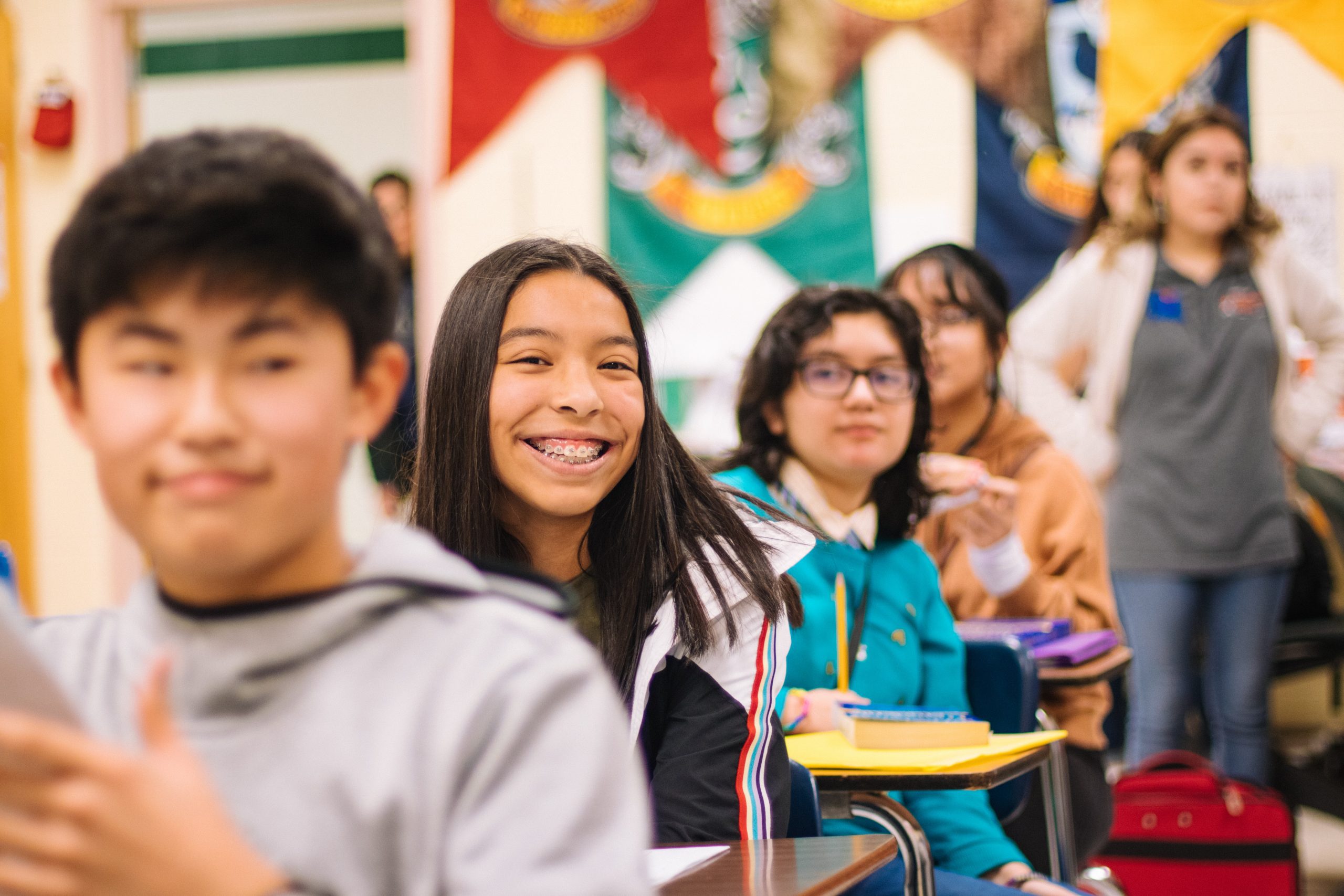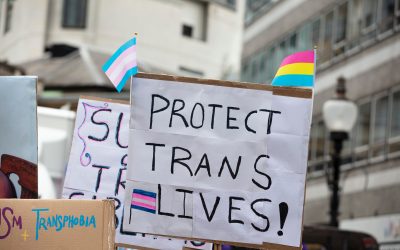
With more youth feeling free to live their authentic sexualities and build relationships that reflect that, it’s up to educators and youth-supporting professionals to keep up momentum for supporting LGBTQ+ young people in schools

By Mariah Cowsert
June 30, 2021
Growing up bisexual in a 2,000-person rural farm town in the Midwest, I dreamt of what it would be like to have real, honest conversations with my friends about crushes, puberty, and how to navigate bullying at school. Yet, I hit a roadblock when all my friends wanted to talk about were boys or what hot beauty tips CosmoGirl magazine (now a discontinued publication, RIP) had to offer that month—when I was more concerned about what it meant to have a crush on a girl in my class.
Aside from a quick AOL search for “Am I Gay” online quizzes in my family’s computer room, there wasn’t much in terms of support for navigating these questions in the early 2000’s (that I knew of) aside from turning to the internet. This is especially true for young people in rural areas who may not know anyone who is out as LGBTQ+ in their community.
For young people growing up in 2021, having access to an in-person or virtual Gender & Sexuality Alliance Club (GSA) can help provide a space to navigate these conversations and get support from their peers. Fortunately for Gen Z youth, the presence of GSAs has been steadily increasing over the past 12 years. According to GLSEN’s 2019 School Climate Survey, the percentage of students reporting that they had a GSA at school has increased from under 40% in 2007 to over 60% in 2019.
Not only are GSA’s and LGBTQ+-friendly community resources more abundant than ever, with more than 4,000 GSA chapters nationwide, more young people are feeling comfortable coming out and/or identifying as LGBTQ+. According to a new survey from Gallup, nearly one in six Gen Z respondents (or 15.9%) are saying they are queer or transgender compared to one in 10 millennials (or 9.1%).
With more youth feeling free to live their authentic sexualities and build relationships that reflect that, it’s up to educators and youth-supporting professionals to keep up momentum for supporting LGBTQ+ young people in schools.
So, let’s dive deeper into GSAs and discuss their importance, how to find one (or start one!), and tips for supporting a school or community-based GSA Club!
What is a Gender & Sexuality Alliance Club?
Gender & Sexuality Alliance Clubs (or GSAs)—formerly known as Gay-Straight Alliance Clubs—are youth-led school or community-based groups organized for the purpose of supporting LGBTQ+ youth and straight allies through discussion, action, friendship, and advocacy.
And while GSAs exist throughout all levels of education, LGBTQ+ student organizations have existed on college campuses since the civil rights era, while the establishment of similar groups in high schools did not occur until the late 1980s.
The first Gay-Straight Alliance Club emerged in 1988 when Kevin Jennings—a history teacher at Concord Academy (a private, coeducational boarding and day school for high school aged students) in Massachusetts—who had just come out as gay, was approached by a student at the school who was straight but was upset by the treatment of gay students by her peers. This interaction sparked Jennings to recruit more teachers at the school, thus forming the first GSA.
GSAs aren’t only for peer support but can also act as vehicles for social change in school climates.
Jennings credits students for both the establishment of the club, as well as for setting the agenda of combatting homophobia, and for changes to Concord Academy’s non-discrimination policy. Jennings went on to co-found the Gay Lesbian and Straight Education Network (GLSEN) in 1990—so it’s no wonder why we’re sharing so many incredible resources from GLSEN with you today!
GSAs aren’t only for peer support but can also act as vehicles for social change in school climates. GSA members are engaged in every type of activism, from promoting education and tolerance in their own local school communities to participating in nationwide events such as National Coming Out Day, National Transgender Day of Visibility, and the National Day of Silence.
What are the benefits of GSAs in schools?
GSAs can help young people share their experiences, bridge empathy gaps, and learn how to work together to combat bullying in their schools. A statewide study in Massachusetts (from more than 15 years ago) found that in schools with GSAs, 52% of students reported that school personnel were supportive of LGBTQ+ students, compared to only 37% of students in schools without GSAs.
The same study found that 75% of students in schools without GSAs reported anti-gay slurs every day compared to 57% of students in schools with GSAs. In addition to these influences on school-related factors, another growing line of research has shown the connection between having a GSA at school and better mental health and health behavior for LGBTQ+ students, including reductions in smoking, drinking, and drug use; sex with casual partners; psychological distress and depressive symptoms; suicidal ideation and behavior; and increased self-esteem.
Want to hear directly from a young person about the benefits of GSAs? Watch this video that shows Elle, a high school senior and founder of the Central Texas GSA Coalition, sharing their perspective about the many benefits of GSAs in their community.
How can I find a GSA Club Near me? Or start a new chapter?
Want to get involved but not sure where to go? You can use the GSA Network’s Find Your Network Map resource to find a GSA club near you or to connect with a virtual club. The map also includes LGBTQ+-friendly youth centers, youth groups, and community centers, so if you don’t have a school-based GSA near you, there may still be resources in your area to plug into! Don’t know what to expect at a GSA club meeting? While every club is unique, you can find out general information about what you can expect when joining a GSA club by reading testimonies directly from young people in GSAs across the country.
Don’t have a GSA club at your school and not sure where to start or if it’s even allowed? (P.S.—it’s permitted like any other school club!) The GSA Network reminds us that if you attend a public school that has other non-curricular clubs, the Federal Equal Access Act states that your school cannot deny the formation of a GSA (or any club, for that matter).
According to the GSA Network, the Federal Equal Access Act also states “your school must treat all clubs the same and let them use school resources in the same way. If a school allows other clubs to meet in classrooms, put up posters and organize school events, then they have to allow your GSA to do the same.”Learn more about your rights when establishing a GSA with this guide on GSA club protections from Lambda Legal that includes information on what schools can and can’t do when students create a GSA club on campus.
You can find out more information on how to start a GSA club on your school campus by checking out GLSEN’s guide on 10 steps to start your GSA. Their guide includes info on how to recruit students to your club, establishing group agreements, and more!
What else do I need to know about working with youth in GSAs?
While most GSA clubs are youth-led, many schools require that clubs have a faculty or teacher advisor to help facilitate and provide support. Are you looking for more information about becoming a GSA advisor at your school?
Here are 5 ways you can get started:
1. Create a safe space.
Draft community agreements that help students feel comfortable joining and participating in the club. By establishing a set of community agreements, you provide a baseline for how to respect each other’s experiences and increase engagement during group meetings. Not sure how to get started? Download GLSEN’s GSA community agreements as a starting place, but also get input from the young people in the club to make sure they’re on par with the needs of the group.
2. Pass the mic.
Remember that the young people are in charge and pass the mic to your students. You may find it helpful to identify a few student GSA club leaders to help with supporting the group, if you want to have a more structured club that’s still youth-led. But remember, you’re there to be an anchor, not to take charge. Young people are the experts of their own lives, so it’s important to make room for them to take the lead! Learn more by reading this article from Edutopia about supporting GSA’s in middle school (P.S.–the information in the article is still handy for high schools staff too!).
3. Check out the GSA Advisor Handbook.
Take a page from the pros and check out the Advisor Handbook from the GSA Network, which includes information on supporting virtual GSAs. Their handbook was created to support GSA advisors and adult allies as they partner with students and organizations to create thriving safe spaces for queer and trans youth.
4. Get involved locally.
While it may be best to start your own GSA on campus (or virtually!) to ensure students have easier access to a local GSA club, there are existing LGBTQ+ community-based groups that host events and provide support for LGBTQ+ young people and their parents or caregivers like Salisbury PFLAG, PFLAG Fairmount, and Hagerstown Hopes. Not local to Maryland? Check out the GSA Network’s club locator map to find a GSA near you!
5. Never stop learning!
Keep learning to help support the young people in your life! Whether you want to get involved as a GSA faculty/teacher advisor or become an askable-adult, it’s important to continue sharpening your skills. Check out GLSEN’s recorded webinars from past GSA summits and the GSA network’s fact sheet, How to be an Awesome Advisor.
Now that you’ve learned all about GSAs, you’re ready to get started supporting—or deepen your support for—young people looking to join (or start!) a welcoming, inclusive club where all LGBTQ+ students can thrive!
As for me, I’ve been able to re-connect with old classmates from my hometown who had similar experiences growing up and am grateful to be supported by my family, chosen family, and my incredible partner (hi, Josh!).
There is strength in finding your people and growing into yourself—all young people deserve to cultivate friendships and relationships that allow them to be their most authentic selves.
Mariah brings an artistic lens to nonprofit communications in her role as Communications Designer. With the bulk of her experience working in social services and at affordable housing organizations—she has a passion for diving deeper into (and helping bridge the gap between) health care and housing. In her free time, Mariah can be found tending to her growing jungle of houseplants, making collage and textile art, reading Mary Oliver poems in nature, and experimenting with new vegetarian recipes. Read more about Mariah.










